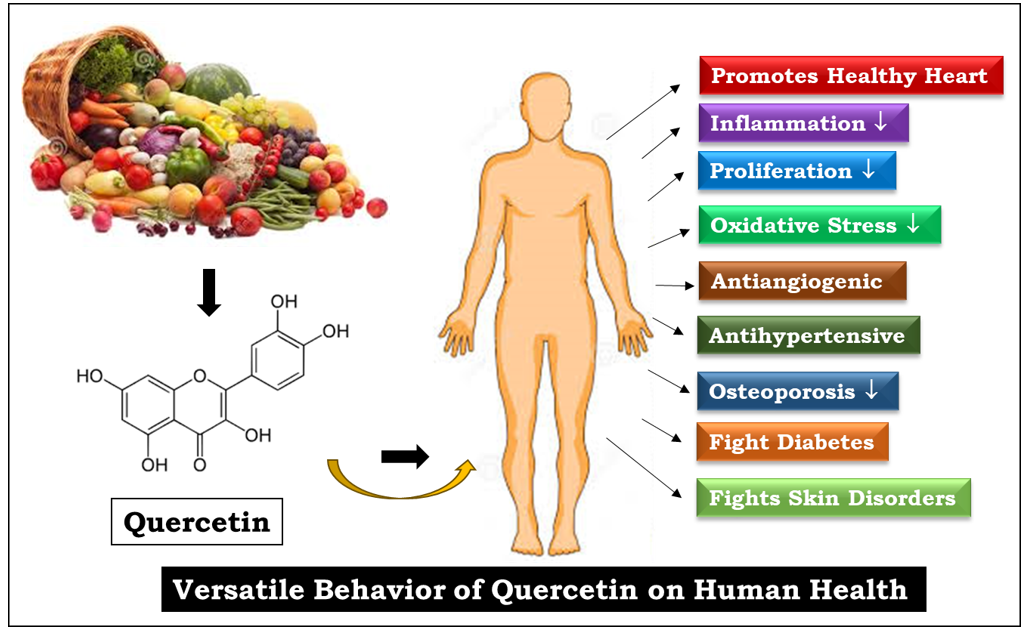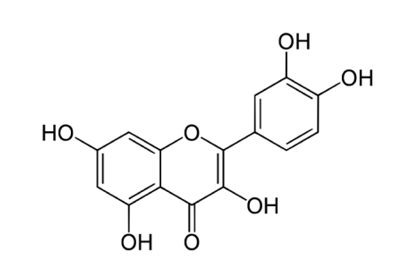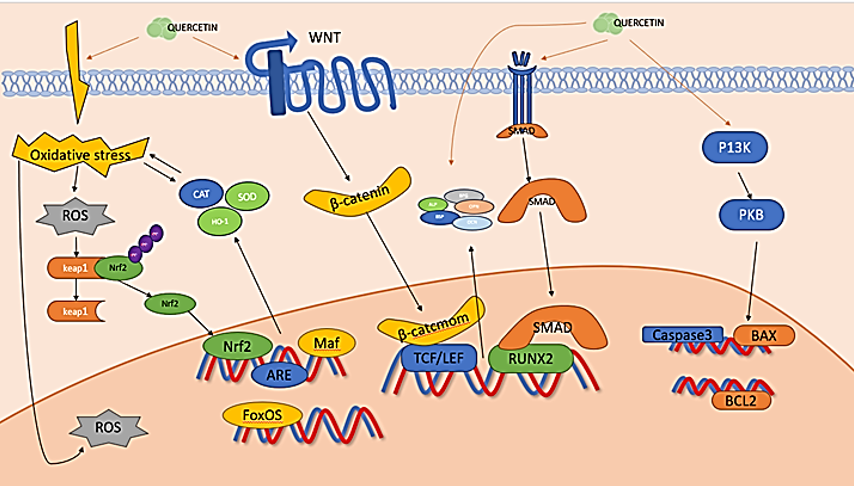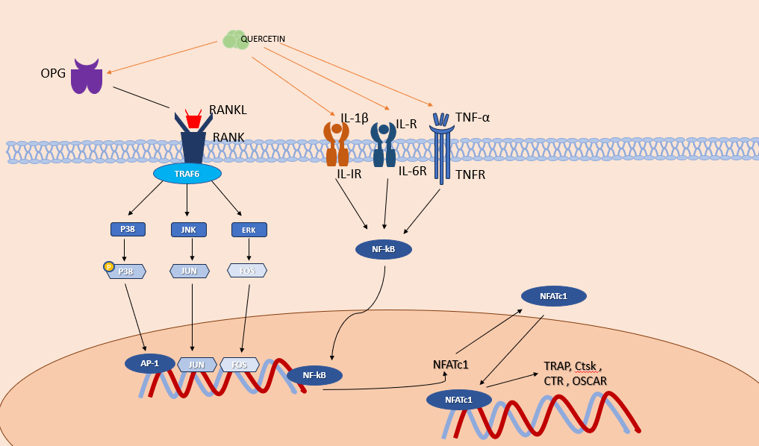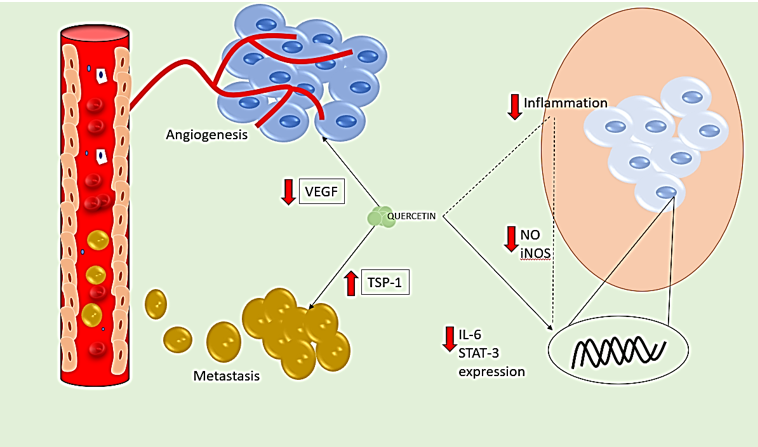Introduction
Quercetin is a flavonoid polyphenol that is considered an important phytochemical. Strong antioxidant flavonoid quercetin, also known as flavanol, is a plant pigment found mostly in onions, grapes, berries, cherries, broccoli, and citrus fruits. This versatile antioxidant has demonstrated defense capabilities against tissue deterioration caused by various drug toxicity levels. 1
Using plants and their phytoconstituents instead of pharmaceuticals has several advantages. It has been established that plant extracts and phytoconstituents have biological effects, such as the capacity to scavenge free radicals, lessen inflammatory disorders, and treat hyperlipidemia and diabetes. Most metabolic diseases hurt the quality of life and are primarily caused by free radicals. In the balanced environment that nature provides a balanced system, one can live a pleasant and healthy life. In recent decades, there has been an increased focus on finding compounds that have antioxidant properties. 2
For the past 30 years, researchers have focused a great deal of attention on quercetin, a special kind of bioflavonoid. Nobel laureate Albert Szent Gyorgyi made the 1930 discovery of bioflavonoids. 3 Flavonoids are a class of naturally occurring substances that vary in their phenolic structure. They can be found in tea, wine, grains, fruits, vegetables, bark, roots, and stems. Before flavonoids were identified as beneficial compounds, these natural products were well-known for their positive health effects. More than 4000 different types of flavonoids are known to exist, and many of them give flowers, fruits, and leaves their lovely colors. 4
The Latin word "Quercetum," which means "Oak Forest," is the source of the name quercetin (3,3',4',5,7-pentahydroxyflavone) (Figure 2), which is a member of the flavonol class that the human body is unable to produce. It has a yellow hue, dissolves poorly in hot water, dissolves well in lipids and alcohol, and is insoluble in cold water. 5
Quercetin has various pharmacological characteristics, including anti-inflammatory, anti-cancer, antiviral, antibacterial, neurologically protective, and anti-obesity effects. 1 Recently, quercetin was granted the GRAS (Generally Recognized as Safe) designation by the US Food and Drug Administration (FDA). 6 This review aims to summarize the pharmacological mechanism of the bioactive flavonoid quercetin.
Discussion
Quercetin role in osteoporosis (Op)
Patients with OP, a common bone disorder, are more likely to fracture because of their weakened bone architecture and decreased bone mineral density. Pharmacotherapy is the main method used to treat OP, and recently, interest in the phytochemical compound quercetin has grown. Through anti-inflammatory and antioxidative mechanisms, this naturally occurring flavonoid supports bone health and metabolic balance while regulating bone marrow mesenchymal stem cells, osteoblasts, and osteoclasts.7
The process through which quercetin facilitates osteoblast-mediated bone growth
Four phases of bone formation are experienced by osteoblasts (OBs): proliferation, extracellular matrix mineralization, extracellular matrix maturation, and apoptosis. 8 Throughout different developmental stages, they are influenced by an array of transcription factors and signaling pathways that ultimately culminate in the completion of normal bone formation. 9 The mechanism through which quercetin promotes osteoblast-mediated bone formation (Figure 3).
OB-specific Mesenchymal stem cells (MSCs) must differentiate into OBs for functional OBs to arise, and this requires the transcription factors runt-associated transcription factor 2/corebinding factor alpha 1 and special protein 7 transcription factor (osterix). 10 Osterix, which is produced only in bone tissue cells and functions as a downstream gene of RUNX2 to play an osteogenic role, is necessary for the differentiation of OBs and the production of new bone. 11 RUNX2 and SP7 mRNA expression levels are demonstrated to be significantly elevated in mouse bone marrow mesenchymal stem cells (mBMSCs) upon administration of 5 μM Quercetin. The conventional Wnt signaling pathway significantly regulates bone resorption and formation. 12 A secreted glycoprotein called Dickkopf-1 binds to LRP5/6 receptors with Wnt proteins competitively, inhibiting the Wnt/β-catenin signaling pathway and leading to bone resorption. quercetin stimulates the osteogenic differentiation of MC3T3-E1 cells by upregulating the levels of β-catenin protein and initiating the Wnt/β-catenin pathway.13 Quercetin promotes the growth and osteogenic differentiation of BMSCs by activating the downstream Wnt/β-catenin pathway by targeting the H19/miR-625-5p axis. However, high concentrations of Quercetin (10 μmol/L) inhibit the Wnt/β-catenin pathway. 14 Quercetin (2 or 5 μM) significantly increases the mRNA levels of ALP, RUNX2, BMP2, and other OB marker genes, and enhances the relative alkaline phosphatase (ALP) activity and matrix mineralization of third-generation mBMSCs, thereby promoting their osteogenic development. 15 Quercetin also enhances the BMP signaling pathway's activation via the endoplasmic reticulum, upregulates the expression of genes that are downstream of it, including OSX, RUNX2, and OPN, and encourages BMSC proliferation and osteogenic differentiation. 16 Quercetin may suppress the production of ROS and FAC-induced apoptosis, upregulate the expression of Bcl-2, and downregulate the expression of caspase-3 and Bax. 17 Quercetin can reduce the excessive production of intracellular ROS brought on by sodium nitroprusside and restore the potential of the mitochondrial membrane, which will lessen chondrocyte apoptosis. This is achieved by altering the Bcl-2/Bax-caspase-3 signaling pathway. 18 Cellular defense mechanisms are strengthened against oxidative damage by upregulating Nrf2 and HO-1 expression during oxidative stress. 19 Quercetin has a dose-dependent effect on BMSCs' HO-1 mRNA expression. 20 It significantly increases Nrf2 nuclear translocation in FAC-induced MC3T3-E1 cells and decreases FAC-induced oxidative stress injury by inducing the Nrf2/HO1 signaling pathway. 21 In addition to increasing the number of mineralized nodules and mineralized matrix accumulation in BMSCs, quercetin treatment significantly increases the expression of OCN and OPN mRNA in BMSCs. Additionally, it encourages BMSCs to develop into osteogenic cells. Pretreatment with Quercetin significantly restores bone mineralization and OCN mRNA and protein expression levels in lipopolysaccharide (LPS)-inhibited MC3T3-E1 cells in a dose-dependent manner. 22
OC-mediated bone resorption inhibition by Quercetin
Osteoclasts (OCs) are multinucleated giant cells with the ability to resorb bone that is created when bone marrow monocyte precursors fuse.23 They promote bone resorption and remodeling by secreting acids and enzymes that degrade the bone matrix. When OCs are overactive or excessive, the balance between OBs and OCs is disrupted, which can lead to excessive bone resorption and OP. Transcription factors regulate the activity and differentiation of OCs. 24 The nuclear factor of activated T cell 1 is the primary regulator of OC differentiation (NFATc1). 25 It controls OC activity and OC-specific genes such as TRAP, Ctsk, calcitonin receptor, and OC-associated receptor by cooperatively activating nuclear factor kappa B (NF-κB), c-Fos, c-jun, and microphthalmia-associated transcription factor (Mitf). Quercetin therapy inhibits the NFATc1 gene and protein expression via the TRAF6/c-fos/NFATc1 signaling pathway, preventing RAW264.7 cells from differentiating into OCs. By inhibiting the expression of NFATc1 induced by RANKL, que-3-O-β-D-glucoside prevents both bone loss and OC differentiation. 26
The OPG/RANKL/RANK signaling pathway is a crucial signaling axis during bone remodeling (Figure 4). In the presence of M-CSF, RANK binds to the C-terminus of RANKL, activating transcription and expression of downstream OC-specific genes and attracting factors associated with the tumor necrosis factor receptor.27 Upon implanting OB-OC-endothelial cells in three cultures on Que-containing hydroxyapatite, the trend of OPG/RANKL levels correlated with the reduction in histone K levels, suggesting that Que inhibits the viability of OC. 28
The main participants in the growth of OC precursors and OC apoptosis, respectively, among the OC precursors are two ERK forms (ERK1/2) and three JNK isoforms (JNK1/2/3). 29 Qué-3-O-β-D-glucuronide significantly lowers JNK and ERK activation in LPS-stimulated RAW264.7 macrophages. 30 Due to its concentration-dependent anti-inflammatory properties, it inhibits the release of PGE and plasmatic NO, as well as the production of COX-2 and iNOS. quercetin acts through the JNK-c-Jun/AP-1 and ERK-c-Fos/AP-1 pathways to prevent apoptosis. 31 The dynamic regulation of both osteoclastogenic and anti-osteoclastogenic cytokines is necessary for maintaining bone homeostasis. Tumor necrosis factor-α (TNF-α) drives OC development by upregulating RANK pro-inflammatory target genes, promoting NF-κB nuclear translocation, disrupting the balance of the RANK-RANKL bio-axis, and increasing OC activity. 32 TNFα and IL-6 accumulation in LPS-induced murine RAW264.7 macrophages is significantly reduced by Que (2 or 5 μM). 33 In macrophages and microglia, que suppresses M1 polarization and significantly reduces the expression levels of M1 markers such as IL-6, TNF-α, and IL-1β. Quercetin inhibits OC activation, significantly reduces TNF-α and IL-1β levels, and minimizes bone loss.34
Quercetin Role nn Cvs Conditions
Acute myocardial infarction
Acute myocardial infarction (AMI), which causes coronary artery blockage, suppression, and interruption of the blood supply to the heart tissues, is the fundamental cause of coronary artery disease. Quercetin is a flavonoid compound with several advantageous properties. A few of these include reducing blood pressure and scavenging reactive oxygen species (ROS), shielding heart tissues from ischemia and ischemia-reperfusion damage, adjusting immune system activity, and encouraging antioxidant activities.35 Strong antioxidative stress properties of Quercetin can be utilized to stop AMI. Quercetin inhibits each type of cardiac dysfunction caused by chronic unpredictable stress (CUS). Quercetin inhibits the CUS-ST segment elevation in rats.36 Quercetin stops the reduction of the GPx antioxidant enzyme when it is induced by CUS. When rats are administered MI, Quercetin keeps their heart muscle cells from dying. Before ischemia, Quercetin pretreatment protects the heart's myocardial tissue from oxidation and inflammation.37 Quercetin postconditioning prevents ischemia/reperfusion via the PI3K/Akt signaling pathway, which reduces apoptosis, though the exact mechanism by which it does so is still unknown. 38 Quercetin post-conditioning dramatically decreased the amount of the infarct and myocardial cell death after myocardial infarction. Quercetin has anti-ischemic effects. It not only protects the heart from MI damage but also reverses its harmful effects, such as apoptosis, structural changes, and matrix metalloproteinase 2 activation. Quercetin or its supplements are therefore present to prevent myocardial infarction.39
Hypertension
QU showed its antihypertensive properties by modifying the kidneys' arachidonic acid (AA). The main metabolites of AA that regulate arterial blood pressure are 20-HETE and EETs. 40 QU is one of the most potent radical oxygen and nitrogen species scavengers. QU significantly reduces MDA, AOPP, and H2O2 levels in the kidney while increasing CAT, SOD, and GSH levels. All of these signs point to quercetin's potential as an antioxidant. NO production improves when inflammation is reduced. NO, an innate vasodilator, can relax blood vessels and smooth muscle contraction.41 QU dramatically increases PGI2 and COX2 levels, which lower blood pressure. ROS affects blood pressure by lowering the production of NO. It is more common to impact the later stages of severe hypertension than the earlier ones.42 QU improves endothelial cell function by scavenging reactive oxygen species. QU inhibits the ACE function in a dose-dependent manner. QU primarily reduces blood pressure by destroying bradykinin and blocking angiotensin II. The principal mechanism by which quercetin lowers blood pressure is through its inhibition of renin-angiotensin-aldosterone (RAAS) and contraction of the VSMC.43 Conversely, in rat models of metabolic disorders, diabetes, and other conditions, quercetin can reduce hypertension. QU has been reported to possess properties that inhibit the Ca2+ channel. Furthermore, by opening Ca2+-activated K+ channels, which in particular cause cells to become hyperpolarized, QU lessens endothelial dysfunction. Increased NO production through membrane hyperpolarization-induced capacitive Ca2+, which is dependent on Ca2+-activated K+ channels, is the cause of this effect.44
Cardiac arrhythmia
One of the most common cardiovascular conditions in the world, cardiac arrhythmia can be deadly in extreme circumstances and can arise on its own or as a result of other conditions. QU controls autophagic response and dramatically reduces inflammatory responses, cardiac fibrosis, mitochondrial oxidative stress, and apoptosis.45 Additionally, QU opens the vital mitoKATP channels for heart health. A mitoKATP is one kind of potassium channel that regulates cell activity and protects heart cells from damage caused by free radicals.46 QU may have antiarrhythmic effects in this method. QU can treat ventricular arrhythmias in rats.47 Similarly, QU and its analogs could inhibit ATXII-induced late sodium currents in rat ventricular myocytes and improve calcium handling and cardiomyocyte contractility to produce antiarrhythmic effects. QU, however, may have cardioprotective and antiarrhythmic effects because it is a cardiac voltage-gated inhibitor.48
Atherosclerosis
Endothelial cells are the first to defend hemostasis during cardiovascular events. The endothelium ages, which promotes atherosclerosis.49 Quercetin protects vessels by increasing blood flow within arteries. In addition, quercetin prevents lipid aggregation and decreases blood levels of LDL, TNF-a, IL-1B, IL-18, and IL-6. Quercetin's capacity to inhibit ROS may contribute to the prevention of atherosclerotic plaques.50 By giving 20 mg/kg/d Quercetin for eight weeks, lipid deficiencies in vascular intima can be effectively alleviated and treatments for atherosclerosis can be developed.51 One of the recently discovered compounds from quercetin, quercetin 7-O sialic acid, has stronger antiatherosclerosis effects than quercetin alone when combined with N acetylneuraminic acid and quercetin. NADPH oxidase is necessary for the development of atherosclerotic lesions in rats, according to a report from a different study. Based on this data, it was concluded that quercetin controls NADH oxidase activity. Additionally, quercetin can regulate ABCA1 levels.52 Quercetin functions by causing cholesterol to exit the body more quickly and by stopping macrophages from producing foam cells. Quercetin increases the number of LXRs because it is a receptor involved in cholesterol metabolism that can coordinate lipid metabolism. There is a novel signaling pathway linked to the suppression of inflammation that lies between several molecular pathways that are responsible for the antiatherosclerosis properties of quercetin. 53 It has been reported that the administration of 100 mg/kg quercetin inhibited the NLRP3 inflammatory activities of macrophages for 16 weeks. Additionally, QU inhibits the synthesis of galectin-3, a material that promotes the formation of atherosclerotic plaques.54 Quercetin has been associated with a decrease in atherosclerosis through the regulation of autophagy. The vast majority of cells linked to atherosclerosis are T lymphocytes and macrophages. When quercetin and docosahexaenoic acid are combined, NF-KB expressions are suppressed. However, quercetin alone can reduce NF-KB translocation, suggesting that it may be a potential preventive measure for atherosclerosis.55
Myocarditis
Myocarditis is the term for heart inflammation. It is connected to cell necrosis and cardiac degeneration. Autoinflammation is a major contributing factor in the etiology of myocarditis, despite the lack of a specific medication for the condition. The induction of experimental autoimmune myocarditis (EAM) is associated with the secretion of cytokines by macrophages and T cells.56 Moreover, QU affects activated macrophages' nitric oxide production. It has been demonstrated that QU is helpful in the treatment of autoimmune-related diseases. The severity of autoimmune myocarditis was significantly reduced after three weeks of QU administration. QU lessens the degree of inflammation by upregulating IL-10 and suppressing proinflammatory cytokines like TNF-α and IL-17. 57
Quercetin Role in Inflammation
In vitro synthesis of cyclooxygenase (COX) and lipoxygenase (LOX), which are normally stimulated by inflammation, has been demonstrated to be inhibited by quercetin.58 Furthermore, studies conducted in vivo have validated the anti-inflammatory properties. One example of quercetin's inhibitory effects is the noticeable reduction of proinflammatory cytokines in cultured fibroblasts.59 10𝜇M quercetin downregulated the synthesis of COX-2, NO, and nuclear factor kappa B (NF-𝜇B). NO, and TNF-𝜇 were lowered by quercetin at concentrations ranging from 10 to 25𝜇M. At 50 and 100 𝜇M, quercetin has been demonstrated to have extra advantages, such as reducing the production of TNF-𝜇and IL-6 in LPS-stimulated RAW 264.7 macrophages.60, 61 Nonetheless, it was most successful in preventing TNF-𝜇 release in macrophages at concentrations between 25 and 50 𝜇M. Finally, at low doses, quercetin (less than 50𝜇M) dramatically increased the anti-inflammatory cytokine IL-10.62 Similarly, 25𝜇M quercetin inhibited LPS-induced production of TNF, IL-1𝜇, IL-6, and IFN-𝜇 in human whole blood. Furthermore, it has been demonstrated that quercetin is an effective pretreatment for apoptotic cell death. Moreover, quercetin would stop stress-activated protein kinases (JNK/SAPK) and p38 MAPK from becoming activated, which would stop the growth-inhibiting effect on cells. Quercetin appears to have potential as a weapon against inflammatory diseases based on several data points. Moreover, it might be advantageous for cells involved in allergic inflammation.63
Inflammation plays a key role in how CAD develops. Increased levels of proinflammatory cytokines stimulate immune-competent and endothelial cells. NF-kB, TNF-α, and IL-1β activations are involved in the development of CAD. Quercetin is associated with a decrease in IL-1β and NF-kB gene expression. It not only inhibits the activation of inflammatory genes but also activates the protein sirtuin 1 (SIRT1). 64 QU prevented endothelial cell damage caused by the SIRT1 protein. QU also prevents lipid peroxidation damage and has potential in the treatment of CAD. Following a two-month regimen of QU 120 mg daily, 85 patients with CAD demonstrated positive characteristics.65 QU eliminates free radicals and reduces the body's oxidation of low-density lipoproteins. QU therapy, which protects cells from oxidative damage, is administered for two months to eighty patients with hyperlipidemia.66 In individuals with CAD, QU at a dosage of 3 grams per day for two months lowers necrosis factor and endothelial cell degeneration. QU is suggested as a potential Angioprotector agent since it increases the statin drug's efficacy.67
Quercetin role in fat
Research indicates that QU downregulated both apoptosis and adipogenesis by inhibiting the activity of enzymes associated with adipogenesis. Meanwhile, there was an increase in MAPK and its substrate, acetyl-CoA carboxylase (ACC).68 Apart from triggering programmed cell death, JNK and ERK phosphorylation were also reduced. It is suggested that by triggering the MAPK signaling pathway, quercetin prevents the process of adipogenesis. At the same time, quercetin blocked the important JNK and ERK pathways, which led to the apoptosis of mature adipocytes. According to some researchers, quercetin regulates lipid metabolism and the expression of genes in the liver.69 Studies have shown that quercetin shields C57B1/6 mice against obesity brought on by a high-fat diet (HFD) by potentially regulating lipogenesis. Significant reductions in the amount of obesity resulting from the diet were observed in mice supplemented with quercetin rather than following the HFD without the supplement.70 The weight of the mice's liver, total white adipose tissue, and body all decreased in the supplement-fed mice. It seems that quercetin's gene profiles linked to lipid metabolism have altered.71
Quercetin Role in Cancer
Anti-proliferation effect
A major factor in the prevention of cancer is the tumor suppressor protein p53, which regulates the cell cycle, apoptosis, and DNA repair.72 Research indicates that quercetin either activates or stabilizes p53, causing hepatocellular carcinoma (HCC) cells to enter cell cycle arrest and eventually die.73 QUs anti-proliferative effect was demonstrated in a different study where it decreased intracellular ROS in HCC cells without affecting p53 expression. Protein kinase C (PKC) and phosphatidyl 3-kinase (PI3K) both play a similar role in enhancing cell survival and proliferation. Through the reduction of PKC, PI3K, and cyclooxygenase (COX-2), quercetin enhanced the expression of p53 and BAX in hepatocellular carcinoma (HepG2) cell lines (Figure 5). 74 As a result, fewer cancer cells developed. It has been demonstrated that quercetin inhibits the growth of melanoma cells A375 by controlling the Wnt/b-catenin signaling pathway proteins, which include DVL2, b-catenin, cyclin D1, Cox2, and Axin2.75 Research on quercetin's effects on the growth and cell cycle of human gastric cancer cells has revealed a connection between the supplement's suppression of the G1 phase of the cell cycle and the proliferation of gastric cancer.76
Anti-angiogenesis effect
Angiogenesis, the process that produces all capillaries, is regulated by several substances, including endostatin, adhesion molecules, and growth factors. An important factor in tumor angiogenesis is the interaction between tumor cells and endothelial cells. 77 VEGF is essential for the growth and survival of endothelial cells, as well as for promoting cell proliferation, raising vascular permeability, extravasating plasma fibrin, depositing cellulose, and stimulating tumor angiogenesis. 78 A diet high in flavonoids may reduce the risk of cancer, according to epidemiological research. Quercetin has shown anti-tumor effects by slowing the growth of blood vessels. 79
Quercetin's Role in Skin Health
QU protects against UV-induced skin damage by suppressing metalloproteinase-1 (MMP-1), a protease enzyme that degrades collagen, as well as lowering AP-1 activity. It interrupts signal transduction pathways to boost NF-κB antagonist activity. It also inhibits cytokine-mediated inflammatory cascade activation and IL-1-stimulated human mast cell IL-6 production. 80 QU also suppresses nitric oxide synthesis and downregulation of nitric oxide synthase, as well as TNF-α expression and function, in mouse models. 81 In acute inflammation, QU has a dose-dependent effect on leukocyte recruitment, lipid peroxidation, chemokine and ROS levels, and antioxidant enzyme activity. It interferes with the balance and synthesis of pro-inflammatory cytokines like IL-17 and TNF-α and anti-inflammatory cytokines like IL-10. By reducing oxidative stress and NF-κB activity, it prevents chronic inflammation by reducing immune cell activation and accumulation on a global scale. 82 Furthermore, it has been shown to work in concert with vitamin C, as ascorbate recycles QU, making it more effective. Its capacity to mend wounds has also been the subject of numerous investigations. 83
QU provides skin-soothing and regenerative properties that promote healing in damaged and aging skin by stabilizing moisture loss from UV and chemical exposure, promoting the regeneration of the skin barrier, and restoring normal hydration levels. 84 Its anti-oxidant properties increase the viability of cells and protect the skin from oxidative stress brought on by extended exposure. Its anti-MMP action is complemented by its senolytic properties and capacity to encourage the renewal of cellular morphology. Since some research suggests quercetin glycosides may have anti-melanogenesis effects, they may be used as a whitening treatment to treat dark, aging patches.85
Quercetin Role in Diabetes
Quercetin has anti-diabetic properties by promoting glucose absorption through an insulin-dependent MAPK pathway. In response to the mechanism's activation in skeletal muscles, the translocation of glucose transporter 4 (GLUT4) has been seen. In contrast, the liver uses MAPK primarily to downregulate the major gluconeogenesis enzymes, thereby inhibiting the production of sugar.86 According to the homeostasis model, the quercetin-treated group's insulin did not rise or fall, and their glucose plasma levels were lower than those of the control group. Animals given 0.08% quercetin also exhibited improvements in liver enzyme activities vital to detoxification processes, reductions in plasma total cholesterol and triacylglycerols, and increases in plasma adiponectin and HDL-cholesterol. 87 By suppressing the overexpression of connective tissue growth factor (CTGF) and preventing the overexpression of TGF-θ1, quercetin has also been shown to improve renal function in diabetic nephropathic rats. End-stage renal disease and diabetic nephropathy are closely associated conditions. Studies reveal that TGF-μ1 and CTGF are essential for the pathophysiological mechanisms of DN. Quercetin's effects on TGF 1 and CTGF renal functions in diabetic Sprague-Dawley rats treated with streptozotocin (STZ) were studied.88 The results showed that rats given quercetin had a lower kidney-to-body weight ratio. The expression of CTGF and TGF 1 is higher in kidney tissues. Those who took quercetin experienced a decrease in overexpression. Finally, it has been shown that quercetin creates an effective in vitro barrier against lens aldose reductase in addition to inhibiting polyol accumulation.89 It has been shown that quercetin helps people with type 2 diabetic neuropathy feel less irritated, numb, and shocked. Furthermore, it has been shown that quercetin treatment improves several quality-of-life measures.90
Quercetin's Role in Neurodiverse
It is commonly accepted that oxidative stress is a major factor in a variety of neurodegenerative diseases, mediates the harmful effects of some neurotoxicants, and is a mechanism for degenerative processes associated with aging. Reactive oxygen species (ROS) cause oxidative stress and damage proteins, lipids, and DNA when they accumulate in cells due to excessive synthesis or insufficient neutralization. The mitochondria are one of the primary sources of ROS in cells; ROS produced there can also target complex I and other electron transport chain components, initiating a cycle that ultimately results in ATP depletion and cell death. 91 Quercetin furthermore inhibits neurodegeneration by controlling autophagy. It has been shown that quercetin reduces the damage that extreme hyperglycemia does to Schwann cell cells by inducing autophagy. Similarly, quercetin increases autophagy in C. elegans to counteract the neurotoxicity of amyloid beta.92, 93
Conclusion
The thorough analysis of quercetin concludes by highlighting its extraordinary potential to treat various health issues. Quercetin is a multifunctional agent that promotes overall well-being due to its ability to fight cancer, osteoporosis, and cardiovascular diseases. It also has promising anti-diabetic and anti-obesity properties. Our review underlines the significance of quercetin as a promising therapeutic avenue for various health conditions by elucidating its diverse mechanisms of action.


